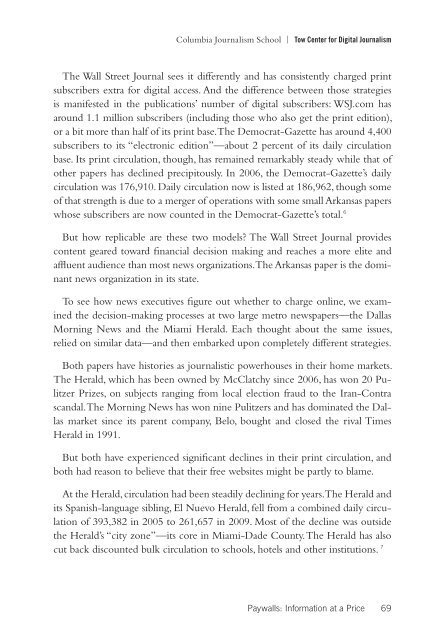What We Know About the Business of Digital Journalism
What We Know About the Business of Digital Journalism
What We Know About the Business of Digital Journalism
Create successful ePaper yourself
Turn your PDF publications into a flip-book with our unique Google optimized e-Paper software.
Columbia <strong>Journalism</strong> School | Tow Center for <strong>Digital</strong> <strong>Journalism</strong>The Wall Street Journal sees it differently and has consistently charged printsubscribers extra for digital access. And <strong>the</strong> difference between those strategiesis manifested in <strong>the</strong> publications’ number <strong>of</strong> digital subscribers: WSJ.com hasaround 1.1 million subscribers (including those who also get <strong>the</strong> print edition),or a bit more than half <strong>of</strong> its print base. The Democrat-Gazette has around 4,400subscribers to its “electronic edition”—about 2 percent <strong>of</strong> its daily circulationbase. Its print circulation, though, has remained remarkably steady while that <strong>of</strong>o<strong>the</strong>r papers has declined precipitously. In 2006, <strong>the</strong> Democrat-Gazette’s dailycirculation was 176,910. Daily circulation now is listed at 186,962, though some<strong>of</strong> that strength is due to a merger <strong>of</strong> operations with some small Arkansas paperswhose subscribers are now counted in <strong>the</strong> Democrat-Gazette’s total. 6But how replicable are <strong>the</strong>se two models? The Wall Street Journal providescontent geared toward financial decision making and reaches a more elite andaffluent audience than most news organizations. The Arkansas paper is <strong>the</strong> dominantnews organization in its state.To see how news executives figure out whe<strong>the</strong>r to charge online, we examined<strong>the</strong> decision-making processes at two large metro newspapers—<strong>the</strong> DallasMorning News and <strong>the</strong> Miami Herald. Each thought about <strong>the</strong> same issues,relied on similar data—and <strong>the</strong>n embarked upon completely different strategies.Both papers have histories as journalistic powerhouses in <strong>the</strong>ir home markets.The Herald, which has been owned by McClatchy since 2006, has won 20 PulitzerPrizes, on subjects ranging from local election fraud to <strong>the</strong> Iran-Contrascandal. The Morning News has won nine Pulitzers and has dominated <strong>the</strong> Dallasmarket since its parent company, Belo, bought and closed <strong>the</strong> rival TimesHerald in 1991.But both have experienced significant declines in <strong>the</strong>ir print circulation, andboth had reason to believe that <strong>the</strong>ir free websites might be partly to blame.At <strong>the</strong> Herald, circulation had been steadily declining for years. The Herald andits Spanish-language sibling, El Nuevo Herald, fell from a combined daily circulation<strong>of</strong> 393,382 in 2005 to 261,657 in 2009. Most <strong>of</strong> <strong>the</strong> decline was outside<strong>the</strong> Herald’s “city zone”—its core in Miami-Dade County. The Herald has alsocut back discounted bulk circulation to schools, hotels and o<strong>the</strong>r institutions. 7Paywalls: Information at a Price 69
















